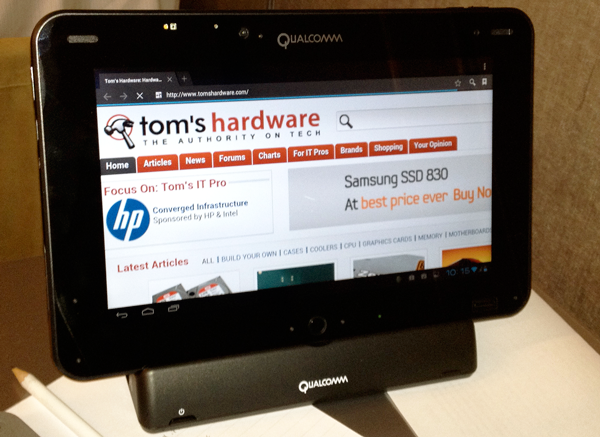Snapdragon S4 Pro: Krait And Adreno 320, Benchmarked
Qualcomm's Fourth-Generation Snapdragon Family Gets A Flagship
Since the beginning of computing, true enthusiasts have wanted to know more about the underlying hardware in their machines. From the old Tandy 1000 with Intel's 8088 processor to modern tablets with ARM-based architectures, components under the hood matter, even if we only use them to enjoy the device itself.
Back in the '80s, standardization made it possible to start swapping parts in and out of an IBM-compatible PC. Although most subsystems were soldered in, we still remember adding serial mouse cards, modems, and "high-end" 20 MB hard drives.
Over time, we were delighted to get access to upgradeable processors (even on-board L2 cache modules), standardized memory formats, faster graphics interfaces, and a broad range of peripherals. It was truly a golden age for power users who knew exactly what they wanted to to spend and where to spend it for the best experience.
What's The Future of Mobile Gaming?
Check out our interview with Four Android And iOS Game Developers for an insider's look of how the software world will evolve, and why hardware plays such an important role.
That model lives on today in enthusiast desktops. However, as we push forward into an era of mobility, compact tablet and smartphone form factors prevent the flexibility typical of a gaming machine at home. When you buy a mobile device, your choices narrow to the capacity of non-volatile memory available for storing music, movies, and pictures.
We've moved backwards in a sense. In the interest of being portable, we're willing to give up the ability to play games at the same quality we're used to. And the smaller you go, the worse performance gets. Because these diminutive platforms are all highly integrated, there's not a darned thing an enthusiast can typically do to make his or her hardware run faster.
Get Tom's Hardware's best news and in-depth reviews, straight to your inbox.
Here's the thing, though. Developers aren't just writing software for iOS or Android anymore. They're actually optimizing and targeting specific platforms now. Nvidia has, perhaps, seen the most success engaging with the software community and getting games enabled on its Tegra 3 SoC that simply won't run as well on other Android-based gadgets. That means you have to do your homework now more than ever.
Despite the truly amazing things we've seen ISVs do for Tegra 3, Nvidia's share of the smartphone market was comparatively small in 2011 (it ranked sixth, according to Strategy Analytics). The top player was Qualcomm with its family of Snapdragon SoCs. Naturally, any move the company makes is going to have a profound impact on the mobile market moving forward.
Qualcomm recently invited us to a benchmark workshop where we were offered an opportunity to go hands-on with its S4 Pro, available in two- and four-core configurations.
Shortly thereafter, we acquired an S4 Pro Mobile Development Platform of our own, allowing us to perform controlled comparisons against other tablets in our lab based on competing architectures. This one's data-heavy, so buckle up!
Current page: Qualcomm's Fourth-Generation Snapdragon Family Gets A Flagship
Next Page Qualcomm's Snapdragon S4 Line-Up: Krait CPUs And Adreno Graphics-
shotgunz Naw, more like give foxconn workers better salary, do something good with mountain of money they have, stop patent trolling, stop silly war with google/samsung and stop lieing. Then maybe Apple will be forgiven.Reply -
luciferano shotgunzNaw, more like give foxconn workers better salary, do something good with mountain of money they have, stop patent trolling, stop silly war with google/samsung and stop lieing. Then maybe Apple will be forgiven.Reply
Well, it'd be a start. I wouldn't go nearly as far as all is forgiven. -
mayankleoboy1 AFAIUI, the PowerVR GPU in ipad3 is more of a brute force architecture. "Just throw more transistors" is its mantra. So its good in current workloads.Reply
The Adreno320 is more refined and optimised arch. Trying to get the most performance from least silicon area. It is still being refined. Hence, it will do well in future applications. -
Why the ST-ericsson 8500 isn't in this list either? too few phone out? Xperia S/P... looks it would rock some of concurrents.. omap..S3...Reply
Please be as exaustive as possible ;) -
Error in the chart on second page.Reply
The cortex A15 DMIPS/MHz should read above the A9. Around 3.5 DMIPS/MHz from the rumblings. -
These krait numbers aren't very impressive if you normalize for clockspeeds.Reply
In fact, they seem to suggest only a very small improvement over A9, if any at all.
